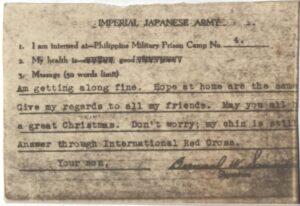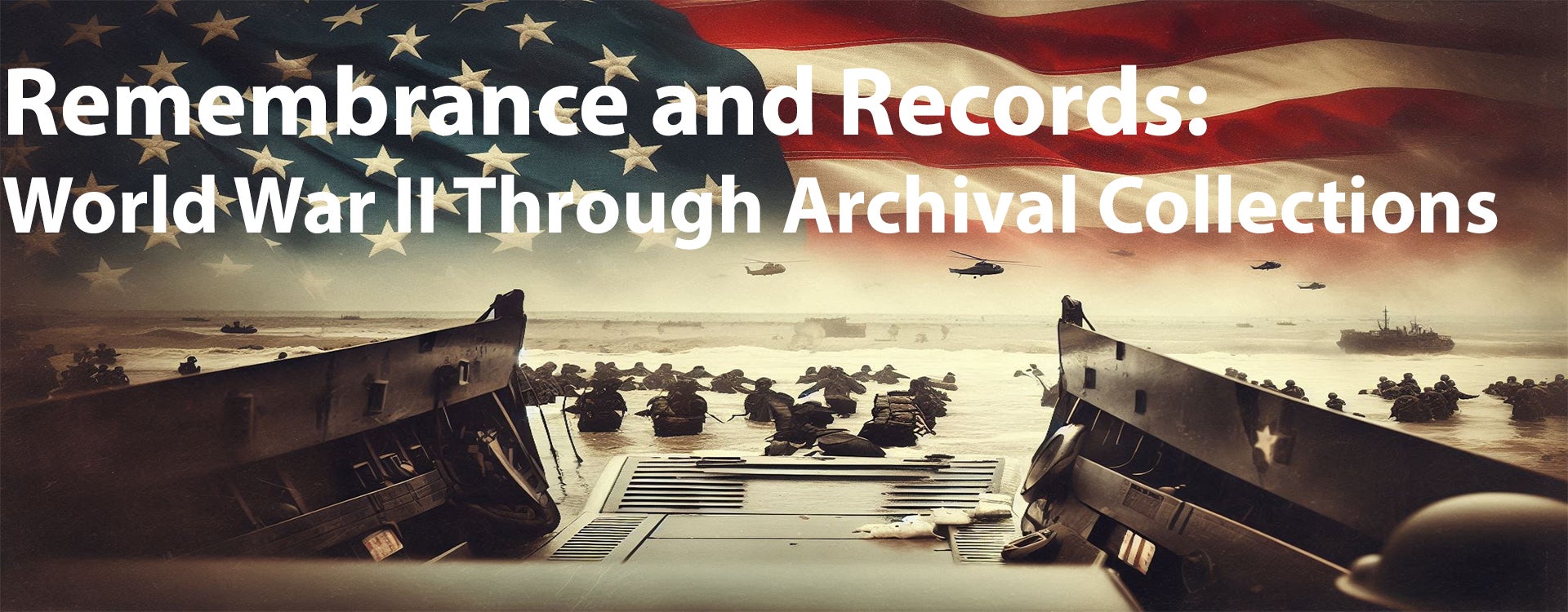Celebrating the Winter Holidays during World War 2
Remembrance and Records: World War II Through Archival Collections
Over the next year, in commemoration of the 80th anniversary of the end of World War II, Joyner Library Special Collections will be highlighting items from the East Carolina Manuscripts Collection that relate to the conflict and the individuals who served.
Celebrating the winter holidays during World War II was a complex and emotional experience for servicemen stationed away from home, often in difficult and even hostile environments. Despite the hardships of war, many soldiers and sailors made efforts to keep the holiday spirit alive, holding onto a sense of normalcy and tradition. Through small but significant gestures, they brought holiday cheer to the frontlines and naval bases, finding ways to connect with loved ones and with each other during one of the most challenging periods of their lives.
Finding Comfort in Shared Traditions

Christmas cards such as this one from the USS Yosemite were given to both servicemen and sent back home to families during the holidays. Image from, U.S. Navy Memorial Foundation Collection: Joseph A. Mileto Papers (#677.040), East Carolina Manuscript Collection, J. Y. Joyner Library, East Carolina University, Greenville, North Carolina, USA.
For many servicemen, the winter holidays provided an opportunity to unite around shared traditions that reminded them of home. Throughout the Pacific islands, North African deserts, and European forests, soldiers and others serving abroad created makeshift celebrations demonstrating creativity and camaraderie. Native trees, small shrubs, or even carefully arranged sticks were used in the absence of traditional Christmas trees. Decorations might include military gear, such as tinsel made from parachute cords, empty shells, or colored paper created from ration boxes. Soldiers would hang makeshift ornaments, write messages to loved ones, and even find ways to display them inside barracks or tents to bring a touch of holiday warmth. In other cases, chaplains, Red Cross workers, and local civilians contributed by setting up community celebrations, holding Christmas services, or offering festive meals, all of which helped lift spirits.
For Jewish soldiers serving in the Allied forces, observing Hanukkah offered its unique challenges. Amidst the devastation of war, celebrating Hanukkah became both a spiritual refuge and a powerful symbol of resilience. Jewish soldiers found ways to light the menorah, using makeshift items like shell casings, tin cans, and candles from home packages, to commemorate the miracle of the Maccabees. The act of lighting the menorah held profound significance, symbolizing the triumph of light over darkness and faith over adversity, mirroring their own experiences in the fight against the Axis powers. For many, these small acts of devotion offered a sense of connection to their faith, families, and the traditions that sustained them, reinforcing the importance of hope during a dark time in history.
Communication and Connection: Letters and Packages

Soldiers would send holiday greetings to their families and friends back home. This piece of “Victory Mail,” sent by Staff Sgt. John James “Jack” Mitchell to his family, makes light of the strict military censorship rules. Image from, Saunders Family Collection (#964), East Carolina Manuscript Collection, J. Y. Joyner Library, East Carolina University, Greenville, North Carolina, USA.
Letters were among the most cherished aspects of a serviceman’s holiday. Mail delivery was often slower during wartime, and sometimes letters could be months old by the time they reached their destination, but receiving a message from home still brought immense joy. Loved ones would send stories from home, holiday cards, photos, and updates, which were read and reread by soldiers longing for connection. For many, these words from home were a lifeline, offering comfort and motivation amid the isolation and stress of war.
Holiday packages also played a critical role in boosting morale. Families would send small gifts, sweets, or homemade treats, anything that could survive the journey. Despite rationing, loved ones would carefully select and pack items like candies, small toiletries, or scarves, often adding handwritten notes and drawings. These care packages, although simple, were full of sentimental value and were usually shared among groups of soldiers, bringing joy and a sense of camaraderie.

A 1941 Christmas menu from the USS ARKANSAS. Image from, U.S. Navy Memorial Foundation Collection: Louis Wallace LeForge Papers (#677.054), East Carolina Manuscript Collection, J. Y. Joyner Library, East Carolina University, Greenville, North Carolina, USA.
Special Holiday Meals
For many servicemen, Christmas dinners served as a central holiday tradition, even amid scarcity. The Red Cross and United Service Organizations (USO) organized special meals, complete with turkey, mashed potatoes, and pie, on both the home front and the battlefront. In some cases, field kitchens prepared hot meals for soldiers in combat zones, though conditions meant they often lacked certain staples. Yet, just having a shared meal could rekindle the holiday spirit. Even soldiers stuck with canned rations would make the best of it, sharing treats from home when available.
Religious Celebrations and Entertainment
Military leaders recognized the importance of morale and organized special events for troops to mark the holiday season. The United Service Organizations (USO) played an essential role, sending entertainers, musicians, and performers to hold shows for troops. Stars like Bob Hope, Marlene Dietrich, and Bing Crosby toured overseas bases, entertaining the troops with comedy routines, songs, and holiday-themed acts. These performances offered much-needed escapism and a reminder of home, helping to keep spirits high and provide a temporary distraction from the harsh realities of war.
Religious services were another part of holiday life for many. Military chaplains organized Christmas and Hanukkah services on the frontlines, provided religious items, and encouraged soldiers to come together to celebrate, even under enemy fire. The best-known example of this occurred during the Battle of the Bulge where troops huddled together in the snow-covered forests of Belgium to attend makeshift holiday services amid one of the war’s most grueling battles. This moment of community and faith, often under lantern light and far from traditional sanctuaries, provided a measure of comfort and a reminder of resilience.
Celebrations on the Front Lines and in POW Camps
For soldiers stationed on the front lines, the holiday season could be especially bittersweet. There were fewer opportunities for traditional celebrations, but they would still try to make the most of the situation. Soldiers sang carols together, while others shared whatever rations or treats, they had managed to save. On rare occasions, unofficial ceasefires were called. In the Battle of the Bulge in December 1944, a famously harsh winter battle, some American and German troops observed a temporary ceasefire on Christmas Eve, exchanging gifts and even singing Christmas carols across enemy lines.

Correspondence from Pvt. Bernard W. Saunders, a Japanese prisoner of war in the Philippines, to his family, ensuring his safety and wishing them a “great Christmas” from the Philippine Military Prison Camp. Image from, Saunders Family Collection (#964), East Carolina Manuscript Collection, J. Y. Joyner Library, East Carolina University, Greenville, North Carolina, USA.
For prisoners of war (POWs), holiday celebrations were often limited, but they found ways to mark the season despite restrictions. Prisoners might make small decorations from
found objects, share stories, or organize small group prayers. In some camps, guards allowed POWs to receive packages from home or even hosted small holiday services, although these instances were often limited and depended on the camp’s conditions.
The Legacy of Wartime Holidays
The wartime holiday celebrations reflected the resilience and determination of those who were far from home during the winter months. Servicemen demonstrated that even amid conflict, the human spirit could find ways to endure. These wartime holiday memories became important parts of the collective stories that veterans carried with them after the war, shaping how they remembered and honored their time in service.
Upon returning home, many veterans carried forward these memories by cherishing the holidays even more deeply with their families. For some, the post-war holiday season became a time of gratitude and reflection, as they remembered their comrades who did not make it back. Others continued the traditions they had started overseas, blending them with family celebrations.
The holiday season during World War II thus remains a poignant reminder of the power of tradition, community, and resilience in the face of adversity. Soldiers found ways to celebrate, connect, and even find joy amid the darkness, creating memories and bonds that lasted a lifetime. Through these acts, they not only preserved the spirit of the holidays but also reinforced the values they were fighting to protect.
Visit the Ship’s Log, as well as Joyner Library’s social media channels, to learn more about materials related to World War II that are a part of the East Carolina Manuscripts Collection’s holdings. Joyner Library Special Collections will be displaying an exhibit of items and individual stories related to World War II during the summer and fall of 2025.
Sources:
- U.S. Navy Memorial Foundation Collection: Joseph A. Mileto Papers (#677.040), East Carolina Manuscript Collection, J. Y. Joyner Library, East Carolina University, Greenville, North Carolina, USA.
- U.S. Navy Memorial Foundation Collection: Louis Wallace LeForge Papers (#677.054), East Carolina Manuscript Collection, J. Y. Joyner Library, East Carolina University, Greenville, North Carolina, USA.
- Saunders Family Collection (#964), East Carolina Manuscript Collection, J. Y. Joyner Library, East Carolina University, Greenville, North Carolina, USA.
